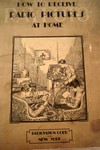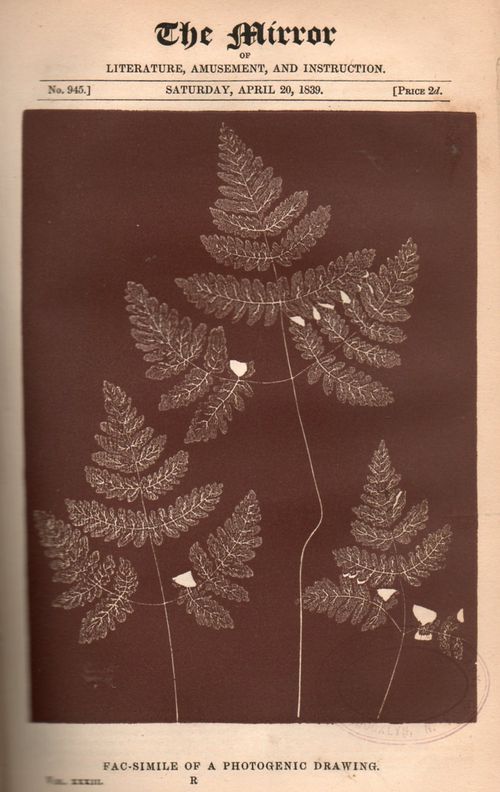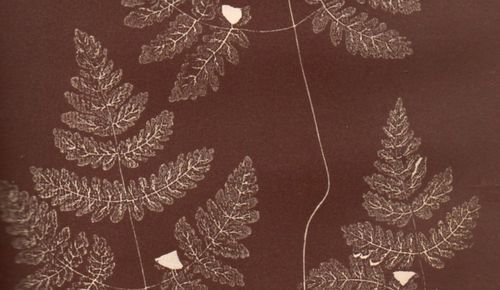JF Ptak Science Books Post 2068
Here are two examples of Things That Almost Were But Weren't: Photography (1839) and Television (1928). The first item contains a woodcut of a heliotype (being the first image of a photograph produced by non-photographic means); the second displays the method for receiving images of radio shows but is not a television.
First: The first published non-photographic image of a non-photograph or "sunpicture", 1839
Golding Bird's (1814-1854) "A Treatise on Photogenic Drawing", published in The Mirror, London, 1839, contains five1 significant and extremely early papers on the photographic process (appearing in The Mirror numbers 945, 946, 947, 949 & 950, April 20-May 25, 1839). [A much larger, more detailed image is available here; I didn't want to lay the book flat on the scanner to get a more detailed image of the copy here at hand.]
It is page 241 (issue no. 945, Saturday April 20) that really peaked my imagination--it contains the first facsimile woodcut of a photogenic drawing, which is essentially the first publication of an image produced by any sort of photographic process. (The image is referred to as "iconic"2 by the Metropolitan Museum of Art, this via the wonder Luminous Lint blog for historical and contemporary photography, here. The process here is the 'sun picture", and while not exactly considered a photograph per se, it is a photographic process, making this the first image of a non-photographic photograph. It predates the first mass-published photograph by four years and the first (entirely) photographically illustrated book (The Pencil of Nature) by six years. The sun picture, or heliotype, was first described in print in 1801 by both Thomas Wedgewood and Humphrey Davy, and although the process was at least 39 years old at this time there are no recorded published images produced by that process. (The woodcut is much larger than usual for The Mirror, and is also of a unique brown/red color, and of a different hue than any other woodcut that we have seen in any of the issues of the first 45 years of this publication. I was concerned at one time that this image was a photographic process of some sort, but it isn't, and I'm convinced that it is a woodcut--a very unusual species of woodcut for this publication, but a woodcut nevertheless.)
Gernsheim states in his History of Photography that the first photographic camera ever made for sale to the public was advertised by Francis West, an optician of 83 Fleet Street, London, and published in this same issue with the Golding Bird.
Bird later reworked these sections of the Mirrour into elements of and a chapter in his Elements of Natural Philosophy;
(being an experimental introduction to the study of the physical
sciences; revised and enlarged third London edition, Philadelphia: Lea
& Blanchard, 1848). This article was reproduced in the Journal of the Franklin Institute in
September 1839 as "Observations on the Application of Heliographic or
Photogenic Drawing to Botanical Purposes; with an account of an
economic mode of preparing the Paper: "in a Letter to the Editor of the
magazine of Natural History".
Secondly: The Pre-Television Proto-Television
 How to Receive Radio Pictures at Home, published by Radiovision
Corp, NY. (Copyright) 1928 (though my copy does have the date-received stamped
verso of the title-page as August 1928, so the pamphlet was definitely published in that year). It is a tall and relatively spare publication of 23pp, nd it is nicely illustrated, with two folding blueprints for the DIY folks, which is all that could be done at this point because there was no retail outlet available for this device. And what this device proposed--right here at the birth of the age of television--was for the radio-listener to receive images relating to the show at home via a fax-machine sort of apparatus.
How to Receive Radio Pictures at Home, published by Radiovision
Corp, NY. (Copyright) 1928 (though my copy does have the date-received stamped
verso of the title-page as August 1928, so the pamphlet was definitely published in that year). It is a tall and relatively spare publication of 23pp, nd it is nicely illustrated, with two folding blueprints for the DIY folks, which is all that could be done at this point because there was no retail outlet available for this device. And what this device proposed--right here at the birth of the age of television--was for the radio-listener to receive images relating to the show at home via a fax-machine sort of apparatus.
"No greater thrill awaits
the radio experimenter than receiving his first picture through the
ether…Not many months will pass before picture broadcasts will be a
part of every radio broadcast" is what the pamphlet claims. This system was offered by Austin G.
Cooley, inventor of the Rayfoto system, "the first authentic radio
picture apparatus". This was a very early attempt at mass
entertainment via a mechanical medium that proved ineffective by
1929/1931 against the advances of television. (By 1927 the great Philo Farnsworth has patented his television; Charles Jenkins gets the first television broadcast license by the Federal Radio Commission in 1928; and by 1929 Vladimir Zworkin demonstrates
the first practical electronic system for both the transmission and
reception of images using his new kinescope tube. (The radiovision
method was something like a facsimile device, offering a static image
every now and again, and was completely outclassed by the moving
image).
Notes:
1. The works includes several photographic essays, including those of Dr. Bird: "A treatise on photogenic drawing", (pp. 241-44); and also "The new art - photography", (pp. 261-2, 281-3, 317-18, 333-335.)
2. "A month later, in the Mirror, his text was illustrated by one of the icons of early photography, a woodcut facsimile of a photogenic drawing of ferns, printed in brown ink and as a negative///"--Luminous Lint.




Comments